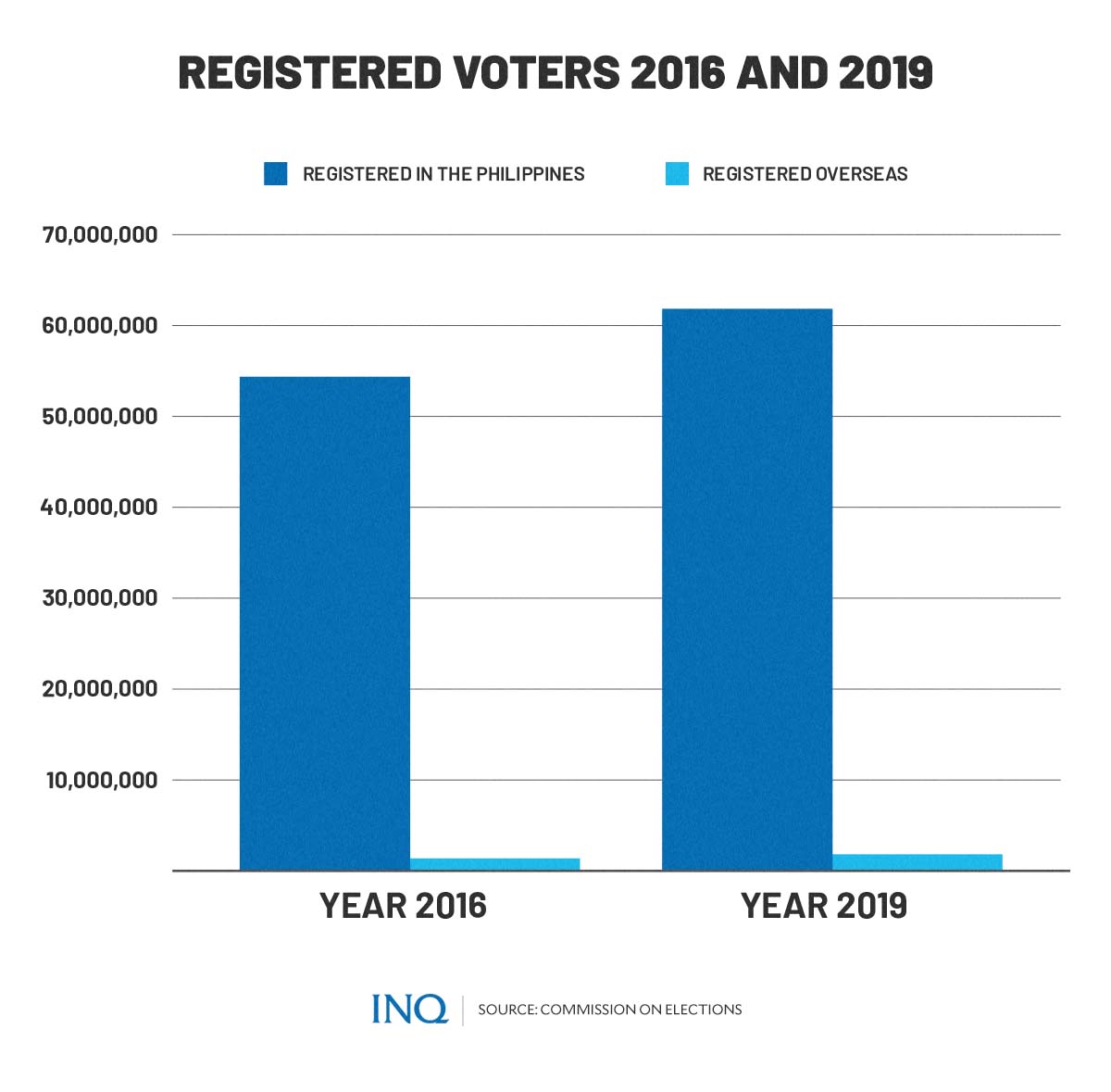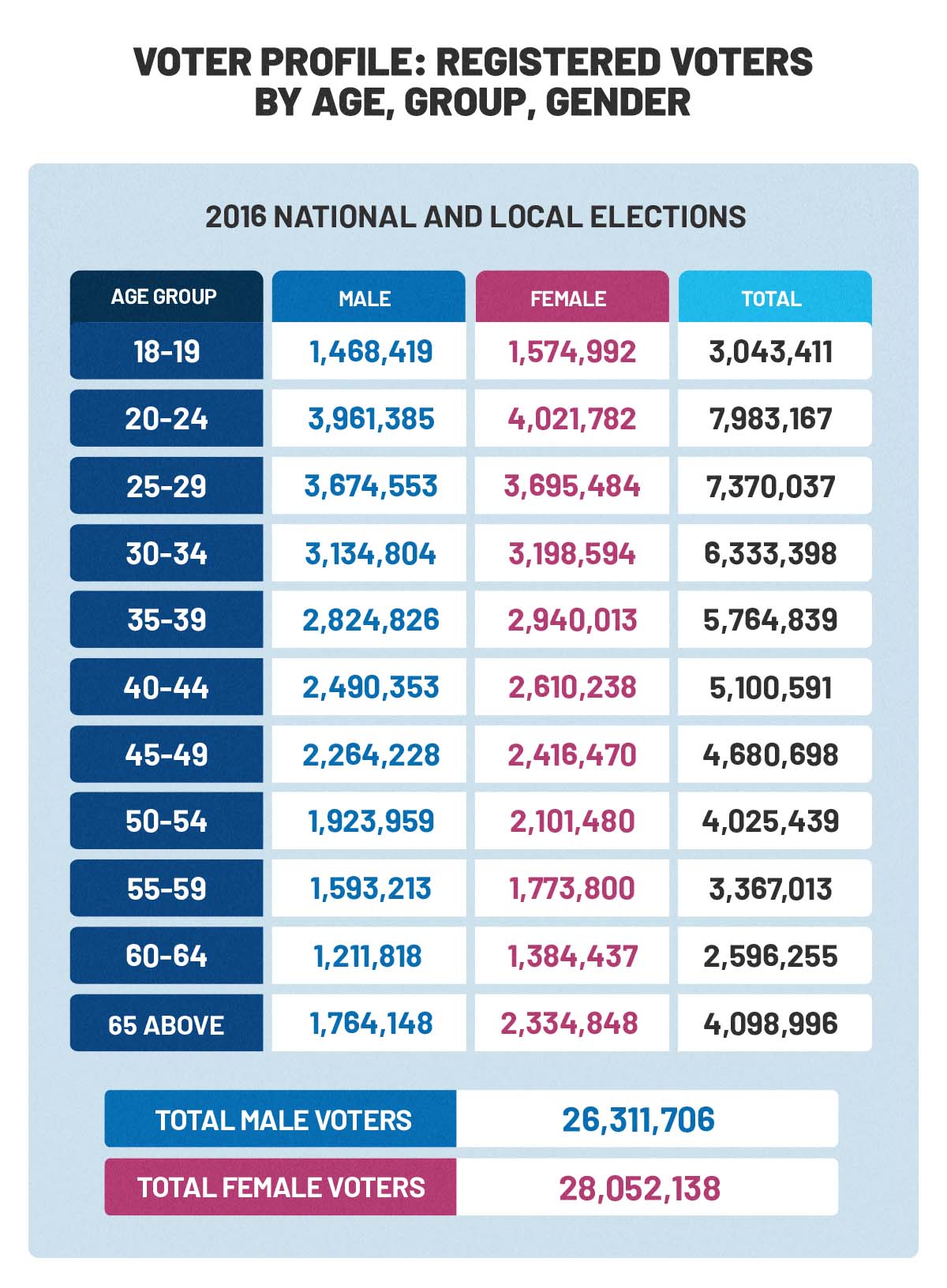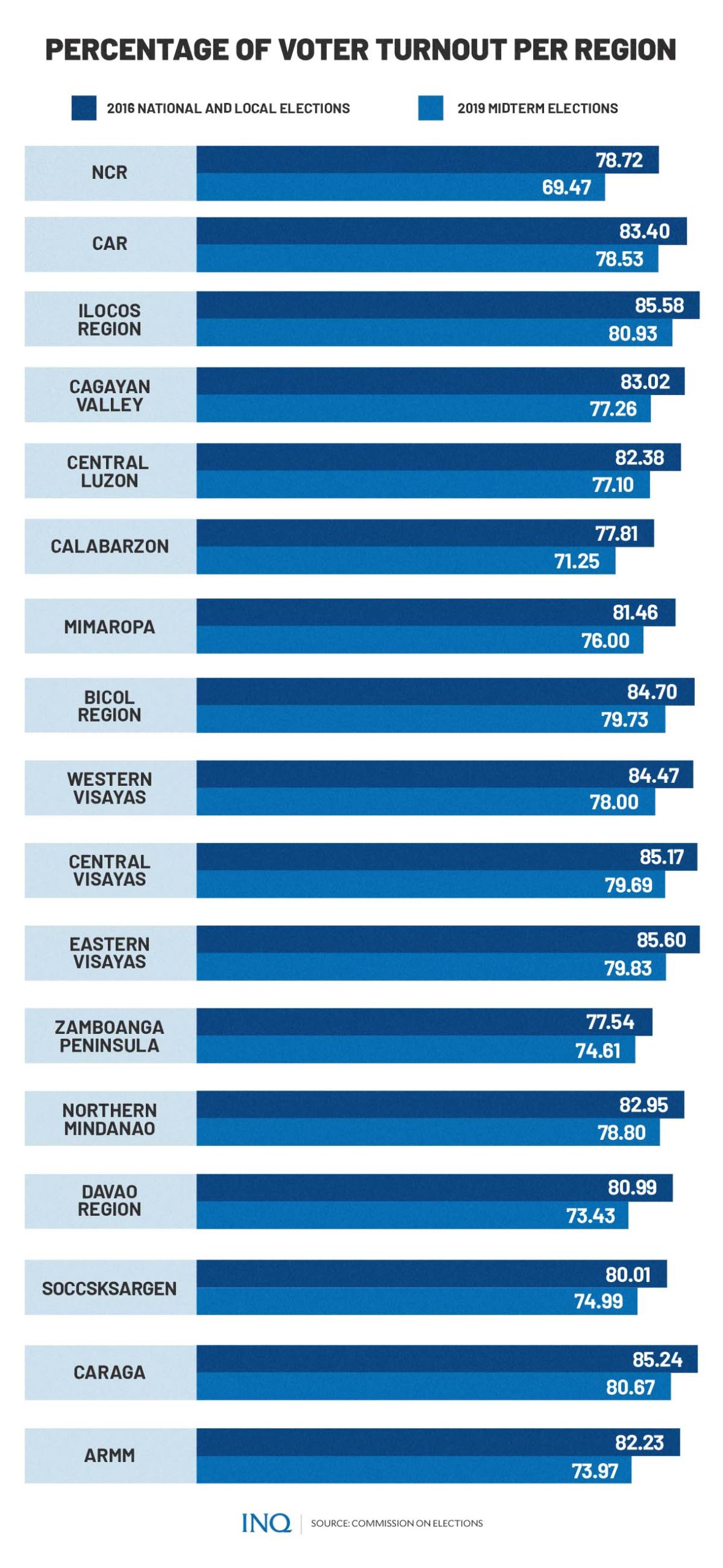By the numbers: More voters in 2022 than in previous polls
MANILA, Philippines—At exactly one month and two days from now, millions of eligible voters are expected to determine the country’s next leaders.
On May 9, the country’s future will be at the hands of around 67.5 million Filipino voters in the Philippines and across the globe.
In total, there are 10 candidates for the position of president—the highest elective post in the government. Nine people are running for vice president and 64 candidates are hoping to land Senate seats.
In this report, INQUIRER.net will focus on voters—specifically, details like this year’s voter profiles and how these compare to records from the 2019 midterm elections and the 2016 national and local elections.
What to expect on May 9?
Data by the Commission on Elections (Comelec) showed that as of December 2021, around 65,745,529 Filipinos in the country who are at least 18 years old had registered to vote on May 9.
Around 1,697,215 Filipinos overseas have registered to vote and participate in the overseas absentee voting (OAV), which the Comelec earlier announced will take place starting April 10.
READ: 1.7 milion OFWs can vote starting April 10
In terms of voter profiles, majority—or 53,795,522—of voters are aged 18 to 57. In total, there are 37,015,901 voters aged 18-41 years old while there are 11,925,708 voters who are aged 58-60 and above.
“We are not saying that those aged 41 years old are still young but it’s within that range, right? Between 31 to 41 we can say they belong to that and that would account for 56 percent actually,” said Comelec spokesperson James Jimenez last February.
“Eighteen to 41-year-olds account for 56 percent of the voting population,” he said.
READ: Comelec: 56% of voting population are aged 18 to 41
Among the top 10 vote-rich regions for this year’s election include:
- CALABARZON: 9,193,096 voters
- NCR: 7,322,361
- Central Luzon: 7,289,791
- Central VIsayas: 5,249,066
- Western Visayas: 5,026,482
- Bicol Region: 3,910,261
- Ilocos Region: 3,546,764
- Davao Region: 3,236,251
- Eastern Visayas: 3,166,262
- Northern Mindanao: 3,060,485
The Cordillera Administrative Region has 1,077,900 voters. Other regions and their voting populations:
- Cagayan Valley: 2,312,798
- Mimaropa: 1,991,599
- Zamboanga Peninsula: 2,298,930
- Soccsksargen: 2,602,492
- Caraga: 1,868,796
- BARMM: 2,385,359
Voter profiles in past elections
More Filipinos registered to vote this year compared to the total registered voters in the 2016 and 2019 elections—54,363,844 in 2016 and 61,843,771 in 2019.
In 2016, there were a total of 26,311,706 male voters and 28,052,138 female voters. The breakdown of the voters that same year in terms of age groups were:
- 18-19: 3,043,411
- 20-24: 7,983,167
- 25-29: 7,370,037
- 30-34: 6,333,398
- 35-39: 5,764,839
- 40-44: 5,100,591
- 45-49: 4,680,698
- 50-54: 4,025,439
- 55-59: 3,367,013
- 60-64: 2,596,255
- 65-above: 4,098,996
During the 2019 midterm elections, there were 30,026,959 male voters and 31,816,812 female voters. Similar to the 2016 elections, majority of voters in 2019 were between ages 20-24 years old.
The number of voters in terms of their age group were as follows:
- 18-19: 2,346,117
- 20-24: 7,729,406
- 25-29: 8,768,710
- 30-34: 7,415,554
- 35-39: 6,594,880
- 40-44: 5,840,763
- 45-49: 5,277,271
- 50-54: 4,658,235
- 55-59: 4,007,089
- 60-64: 3,273,778
- 65-above: 5,868,289
How Filipinos voted in 2016 and 2019
However, while data showed that there were more registered voters in 2019 than in 2016, the voter turnout showed a downward trend.
Out of the 54,363,844 registered voters in 2016, around 81.95 percent or 44,549,848 voters actually went out and voted.
The voter turnout during this year was highest in Eastern Visayas with 85.60 percent. It was followed by Ilocos Region with 85.58 percent, Caraga with 85.24 percent, Central Visayas with 85.17 percent, and Bicol Region with 84.70 percent.
The voter turnout for the other regions in 2016 was:
- NCR: 78.62 percent
- CAR: 83.40 percent
- Cagayan Valley: 83.02 percent
- Central Luzon: 82.38 percent
- CALABARZON: 77.81 percent
- MIMAROPA: 81.46 percent
- Western Visayas: 84.47 percent
- Zamboanga Peninsula: 77.54 percent
- Northern Mindanao: 82.95 percent
- Davao Region: 80.99 percent
- Soccsksargen: 80.01 percent
- ARMM: 82.23 percent
The overall voter turnout continued to go down in 2019, when only 75.90 percent of the 46,937,139 registered voters were able to cast their votes.
That year, the highest shares of voter turnout in the country came from the Ilocos Region with an 80.93 percent voter turnout and Caraga with 80.67 percent voter turnout. The twelve other regions, including NCR, had a voter turnout below 80 percent.
- NCR: 69.47 percent
- CAR: 78.53 percent
- Cagayan Valley: 77.26 percent
- Central Luzon: 77.10 percent
- CALABARZON: 71.25 percent
- MIMAROPA: 76.00 percent
- Bicol Region: 79.73 percent
- Western Visayas: 78.00 percent
- Central Visayas: 79.69 percent
- Eastern Visayas: 79.83 percent
- Zamboanga Peninsula: 74.61 percent
- Northern Mindanao: 78.80 percent
- Davao Region: 73.43 percent
- Soccsksargen: 74.99 percent
- ARMM: 73.97 percent
Comelec said prior to the May 2019 elections that although the number of voters in these elections was higher compared to more than 50 million in 2016, voter turnout was expected to be only 75 to 78 percent.
According to Jimenez, the expectation of a lower turnout was due to people’s preference to vote only when the presidency is at stake.
READ: Comelec expects 78% voter turnout
Still, former Comelec Commissioner Rowena Guazon pointed out last year that the average 70 percent voter turnout during the previous elections was already high by Philippine standards.
However, Guanzon noted that 2022’s voter turnout could continue to go down due to fears caused by the ongoing COVID-19 pandemic.
READ: Comelec’s Guanzon sees lower voter turnout in 2022 national polls
This was contrary to Jimenez’s statement last January, where he stated that Comelec expects a big turnout despite the still increasing cases of COVID-19 in the country.
“No, in fact, we are expecting a high turnout,” Jimenez said over ANC when asked if the poll body is expecting a low voter turnout.
READ: No matter what, 2022 elections will be a big turnout—Comelec spox
Fewer registered overseas voters
In February 2020, as the world grappled with the pandemic, the Philippine government began the repatriation of thousands of Filipinos that officials classified as either OFWs or overseas Filipinos.
By the end of 2020, the Philippines saw an unprecedented volume of repatriated citizens—791,623 Filipinos, according to a study of International Organization for Migration (IOM) United Nations Migration.
READ: ‘Biggest ever repatriation in PH history’ is ongoing
The reverse diaspora and threats brought by the COVID-19 have also disrupted the number of overseas absentee voters, causing the figures to drop for the first time since overseas voting was first allowed in 2014.
Data from Comelec showed that around 1,677,631 overseas absentee voters registered to vote this year.
This was lower than the total 1,822,173 registered overseas voters in 2019. In 2016, the poll body recorded 1,376,067 registered voters across the globe.
Majority of registrations for the 2022 elections were from the Middle East and Africa region with a total of 786,997 overseas absentee voters. It was followed by Asia Pacific with 450,282; North and Latin America region with 306,445; and Europe with a total of 153,491 registered overseas voters.
The top ten countries which had the highest shares of registered overseas absentee voters for the May 9 elections were:
- United Arab Emirates (UAE): 290,182 voters
- Saudi Arabia: 282,605 voters
- United States of America (US): 198,935 voters
- HongKong: 93,886 voters
- Canada: 90,545 voters
- Singapore: 84,877 voters
- Kuwait: 82,021 voters
- Taiwan R.O.C.: 72,779 voters
- Japan: 69,477 voters
- Qatar: 40,519 voters





